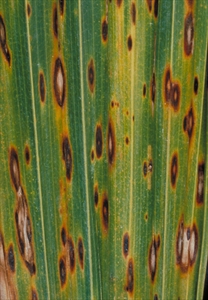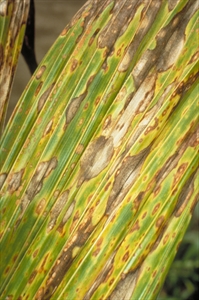Coconut seedling blight
Pacific Pests, Pathogens and Weeds - Online edition
Pacific Pests, Pathogens & Weeds
Coconut seedling blight (075)
Bipolaris incurvata (previously known as Drechslera incurvata, Helminthosporium incurvatum). Another species, Bipolaris setariae (Cochliobolus setariae) was identified causing a leaf spot in nursery gardens in Hainan Province, China, in 2012.
Southeast Asia, the Caribbean, Oceania. It is recorded from Fiji, Federated States of Micronesia, French Polynesia, New Caledonia, Papua New Guinea, Samoa, Solomon Islands, and Vanuatu.
Coconut
The leaf spots are at first small, oval and brown; later, they grow up to 15 mm long, light brown or grey in the middle with a broad dark margin (Photo 1). Often the spots join together causing a leaf blight (Photo 2).
Spores of the fungus, which are mostly formed on the underside of the leaf spots during wet weather, are spread by wind and rain. The fungus needs high levels of humidity for sporulation, and the spores need dew or rain for infection.
The disease is only of importance in the nursery; after transfer to the field it is rarely important. Weak seedlings, growing under stress - crowding, poor nutrition and too much shade - are most affected, but the disease also damages those in nurseries that are well maintained. Infection causes leaves to dry up and die early, and the defoliation slows growth.
This is a distinctive disease on seedlings, especially in nurseries where they are crowded together. Look for large numbers of oval brown leaf spots that rapidly expand becoming light grey in the centre; they join together and develop into a blight, killing large areas of the leaves.
CULTURAL CONTROL
Make sure that the seedlings have the necessary conditions for rapid growth, i.e., sufficient water, correct nutrition and enough space to grow.
- In general, nitrogen increases disease severity - it has been found to increase spore production - and can, indirectly, lead to death of the seedlings. By contrast, potassium increases leaf resistance to infection, and results in lower levels of disease.
- Plants in the nursery should be adequately spaced to allow free movement of air between them.
- Reduce the level of shade, or grow seedlings without shade.
RESISTANT VARIETIES
None known
CHEMICAL CONTROL
Fungicides should only be considered after the reduction of shade and the application of fertiliser, especially potassium. If fungicides are required, use chlorothalonil, copper oxychloride or mancozeb.
AUTHORS Helen Tsatsia & Grahame Jackson
Information from CABI (2019) Bipolaris incurvata (coconut leaf spot). Crop Protection Compendium. (https://www.cabi.org/cpc/datasheet/19827); and McKenzie, E. (2013) Bipolaris incurvata: PaDIL - http://www.padil.gov.au; and from Uchida JY (undated) Bipolaris incurvata. Crop Knowledge Master. University of Hawai'i at Manoa. (http://www.extento.hawaii.edu/kbase/default.htm). Photo 1&2 Kohler F, et al. (1997) Diseases of cultivated crops in Pacific Island countries. South Pacific Commission. Pirie Printers Pty Limited, Canberra, Australia.
Produced with support from the Australian Centre for International Agricultural Research under project PC/2010/090: Strengthening integrated crop management research in the Pacific Islands in support of sustainable intensification of high-value crop production, implemented by the University of Queensland and the Secretariat of the Pacific Community.





